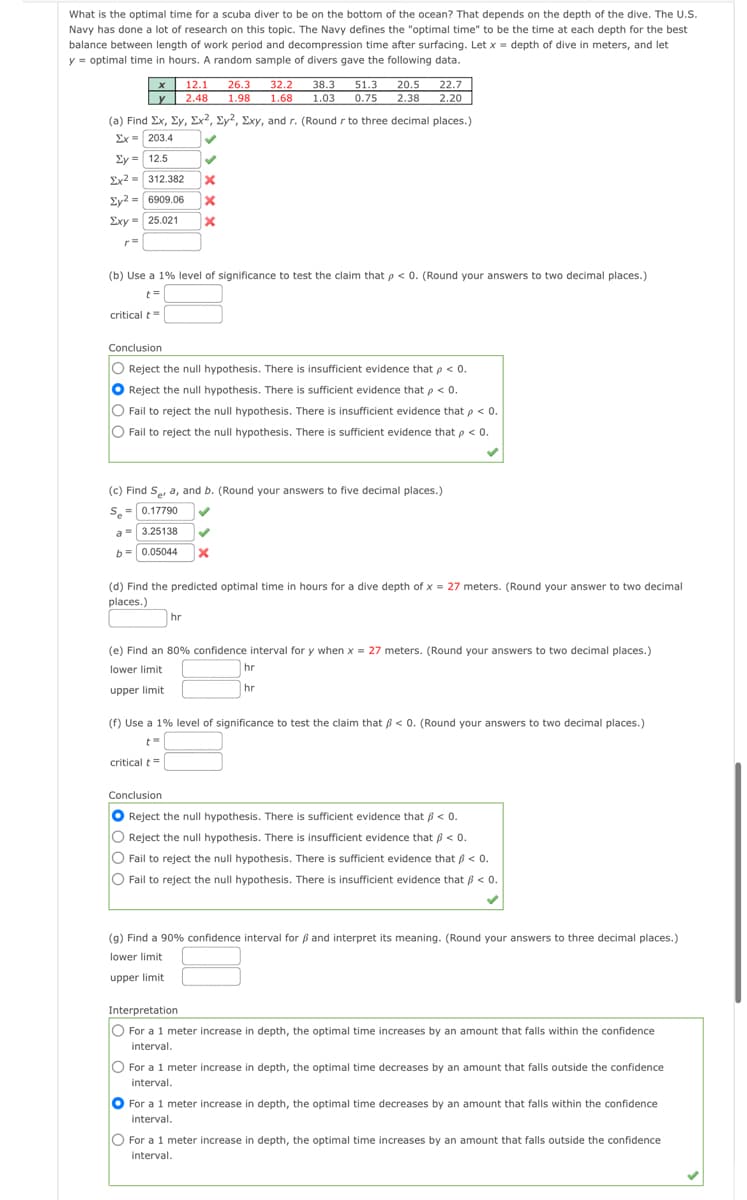What is the optimal time for a scuba diver to be on the bottom of the ocean? That depends on the depth of the dive. The U.S Navy has done a lot of research on this topic. The Navy defines the "optimal time" to be the time at each depth for the best balance between length of work period and decompression time after surfacing. Let x = depth of dive in meters, and let y = optimal time in hours. A random sample of divers gave the following data. | x 12.1 2.48 26.3 1.98 38.3 51.3 20.5 22.7 32.2 1.68 1.03 0.75 2.38 2.20 (a) Find Ex, Ey, Ex?, Ey², Exy, and r. (Round r to three decimal places.) Ex= 203.4 Ey = 12.5 Ex2 = 312.382 x Ey2 = 6909.06 x Exy = 25.021 (b) Use a 1% level of significance to test the claim that p< 0. (Round your answers to two decimal places.) critical t
What is the optimal time for a scuba diver to be on the bottom of the ocean? That depends on the depth of the dive. The U.S Navy has done a lot of research on this topic. The Navy defines the "optimal time" to be the time at each depth for the best balance between length of work period and decompression time after surfacing. Let x = depth of dive in meters, and let y = optimal time in hours. A random sample of divers gave the following data. | x 12.1 2.48 26.3 1.98 38.3 51.3 20.5 22.7 32.2 1.68 1.03 0.75 2.38 2.20 (a) Find Ex, Ey, Ex?, Ey², Exy, and r. (Round r to three decimal places.) Ex= 203.4 Ey = 12.5 Ex2 = 312.382 x Ey2 = 6909.06 x Exy = 25.021 (b) Use a 1% level of significance to test the claim that p< 0. (Round your answers to two decimal places.) critical t
Linear Algebra: A Modern Introduction
4th Edition
ISBN:9781285463247
Author:David Poole
Publisher:David Poole
Chapter4: Eigenvalues And Eigenvectors
Section4.6: Applications And The Perron-frobenius Theorem
Problem 25EQ
Related questions
Question

Transcribed Image Text:What is the optimal time for a scuba diver to be on the bottom of the ocean? That depends on the depth of the dive. The U.S.
Navy has done a lot of research on this topic. The Navy defines the "optimal time" to be the time at each depth for the best
balance between length of work period and decompression time after surfacing. Let x = depth of dive in meters, and let
y = optimal time in hours. A random sample of divers gave the following data.
20.5
2.38
12.1
26.3
x
LY 2.48
32.2
1.68
38.3
51.3
22.7
1.98
1.03
0.75
2.20
(a) Find Ex, Ey, Ex2, Ey2, Exy, and r. (Round r to three decimal places.)
Ex = 203.4
Ey = 12.5
Ex2 = 312.382
Ey2 = 6909.06
Exy = 25.021
(b) Use a 1% level of significance to test the claim that p < 0. (Round your answers to two decimal places.)
t =
critical t
Conclusion
O Reject the null hypothesis. There is insufficient evidence that p < 0.
O Reject the null hypothesis. There is sufficient evidence that p < 0.
O
Fail to reject the null hypothesis. There is insufficient evidence that p < 0.
O Fail to reject the null hypothesis. There is sufficient evidence that p < 0.
(c) Find Se a, and b. (Round your answers to five decimal places.)
S = 0.17790
3.25138
a
b= 0.05044
(d) Find the predicted optimal time in hours for a dive depth of x = 27 meters. (Round your answer to two decimal
places.)
hr
(e) Find an 80% confidence interval for y when x = 27 meters. (Round your answers to two decimal places.)
lower limit
hr
upper limit
hr
(f) Use a 1% level of significance to test the claim that p < 0. (Round your answers to two decimal places.)
t=
critical t
Conclusion
Reject the null hypothesis. There is sufficient evidence that p < 0.
O Reject the null hypothesis. There is insufficient evidence that ß < 0.
Fail to reject the null hypothesis. There is sufficient evidence that ß < 0.
O Fail to reject the nll hypothesis. There is insufficient evidence that ß < 0.
O
(g) Find a 90% confidence interval for ß and interpret its meaning. (Round your answers to three decimal places.)
lower limit
upper limit
Interpretation
O For a 1 meter increase in depth, the optimal time increases by an amount that falls within the confidence
interval.
O For a 1 meter increase in depth, the optimal time decreases by an amount that falls outside the confidence
interval.
O For a 1 meter increase in depth, the optimal time decreases by an amount that falls within the confidence
interval.
O For a 1 meter increase in depth, the optimal time increases by an amount that falls outside the confidence
interval.
Expert Solution
This question has been solved!
Explore an expertly crafted, step-by-step solution for a thorough understanding of key concepts.
This is a popular solution!
Trending now
This is a popular solution!
Step by step
Solved in 2 steps

Recommended textbooks for you

Linear Algebra: A Modern Introduction
Algebra
ISBN:
9781285463247
Author:
David Poole
Publisher:
Cengage Learning

Linear Algebra: A Modern Introduction
Algebra
ISBN:
9781285463247
Author:
David Poole
Publisher:
Cengage Learning